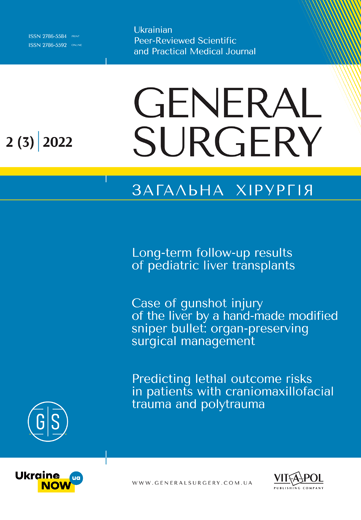Anatomy-based treatment strategy for abdominal and retroperitoneal cystic lymphatic malformations in children
DOI:
https://doi.org/10.30978/GS-2022-2-39Keywords:
children, sclerotherapy, minimally invasive surgery, abdominal cysts, abdominal and retroperitoneal lymphatic malformationsAbstract
Lymphatic malformations (LMs) are rare congenital benign malformations of the lymphatic system, consisting of fluid‑filled cysts or channels with unusual growth. The low incidence of LMs leads to a challenging differential diagnosis and a complicated choice of further treatment strategies. In this study, we analyzed our experience in the treatment of abdominal and retroperitoneal cystic LMs and proposed an anatomy‑based treatment strategy that could improve the treatment outcomes.
Objective — to prove that the anatomical localization of LM influences treatment effectiveness and should be taken into account when making treatment decisions.
Materials and methods. Out of 240 pediatric patients who underwent treatment for cystic LMs at a single center from December 2012 to December 2020, 43 (19.1 %) were diagnosed with abdominal and retroperitoneal LMs. The follow‑up period was 3.50 ± 2.16 years.
Results. Surgical resection of abdominal LMs without evident connection with cisterna chyli does not lead to a recurrence. Sclerotherapy is the best treatment option for retroperitoneal LMs. Diffuse mesentery affection can be successfully treated by sirolimus systemic therapy. According to a logistic regression model, initial choice of LM treatment without considering anatomical localization influences the risks of LM treatment failure (p = 0.000503). All patients in our study group received the following treatments: laparoscopic resections (n = 10, 23.2 %), videoassisted resections (n = 11, 25.5 %), laparotomy resections (n = 9, 20.9 %), sclerotherapy (n = 4, 9.3 %), sclerotherapy and surgery combination (n = 1, 2.3 %), sirolimus systemic therapy (n = 2, 4.6 %), and splenectomy (n = 1, 2.3 %). Six (13.4 %) patients are under dynamic observation. The recommended technique for treating abdominal LMs produced excellent outcomes in 35 (81.4 %) patients, good outcomes in 5 (11.6 %) patients, satisfactory outcomes in 2 (4.7 %) patients, and unsatisfactory outcomes in 1 (2.3 %) patient.
Conclusions. Treatment strategies for abdominal and retroperitoneal LMs should be based on their anatomical localization. Retroperitoneal localization indicates a high risk of surgical treatment failure (p = 0.0006).
References
Benzar IM, Levytskyi AF, Diehtiarova DS, Godik OS, Dubrovin OH. Treatment of lymphatic malformations in children. 10 years of experience. Paediatric Surgery. 2022;(2):5-14. doi:10.15574/PS.2022.75.5 [in Ukrainian].
Chaudry G, Burrows PE, Padua HM, Dillon BJ, Fishman SJ, Alomari AI. Sclerotherapy of abdominal lymphatic malformations with doxycycline. Journal of Vascular and Interventional Radiology. 2011;22(10):1431-5. doi:10.1016/j.jvir.2011.06.021.
Chiappinelli A, Forgues D, Galifer RB. Congenital abdominal cystic lymphangiomas: what is the correct management? The Journal of Maternal-Fetal & Neonatal Medicine. 2011;25(7):915-9. doi:10.3109/14767058.2011.600364.
Cryer R, Gera S, Gera P. Multi-disciplinary treatment of retroperitoneal lymphatic malformations. Journal of Pediatric Surgery Case Reports. 2020;62:101645. doi:10.1016/j.epsc.2020.101645.
de Perrot R, Morel, Coultre LE. Abdominal lymphangioma in adults and children. British Journal of Surgery. 1998;85(3):395-7. doi:10.1046/j.1365-2168.1998.00628.x.
Gilony D, Schwartz M, Shpitzer T, Feinmesser R, Kornreich L, Raveh E. Treatment of lymphatic malformations: a more conservative approach. Journal of Pediatric Surgery. 2012;47(10):1837-42. doi:10.1016/j.jpedsurg.2012.06.005.
https://www.issva.org/UserFiles/file/ISSVA-Classification-2018.pdf.
Jiao-ling L, Hai-ying W, Wei Z, Jin-rong L, Kun-shan C, Qian F. Treatment and prognosis of fetal lymphangioma. European Journal of Obstetrics & Gynecology and Reproductive Biology. 2018. doi:10.1016/j.ejogrb.2018.10.031.
Lal A, Gupta P, Singhal M, et al. Abdominal lymphatic malformation: Spectrum of imaging findings. Indian J Radiol Imaging. 2016;26:423-8. doi:10.4103/0971-3026.195777.
Lee S, Park J. Abdominal lymphatic malformation in children. Advances in Pediatric Surgery. 2018;24(2):60. doi:10.13029/aps.2018.24.2.60.
Méndez-Gallar R, Bautista A, Estévez E, Rodríguez-Barca P. Abdominal cystic lymphangiomas in pediatrics: surgical approach and outcomes. Acta Chirurgica Belgica. 2011;111(6):374-7. doi:10.1080/00015458.2011.11680776.
Nam SH, Kim DY, Kim SC, Kim IK. The surgical experience for retroperitoneal, mesenteric and omental cyst in children. Journal of the Korean Surgical Society. 2012;83(2):102. doi:10.4174/jkss.2012.83.2.102.
Okur H, Kucukaydin M, Ozokutan BH, et al. Mesenteric, omental, and retroperitoneal cysts in children. Eur J Surg. 1997;163:673-7. PMID: 9311474.
Olivieri C, Nanni L, De Gaetano AM, Manganaro L, Pintus C. Complete resolution of retroperitoneal lymphangioma with a single trial of OK-432 in an infant. Pediatrics & Neonatology. 2016;57(3):240-3. doi:10.1016/j.pedneo.2013.06.011.
Shankar KR, Roche CJ, Carty HML, Turnock RR. Cystic retroperitoneal lymphangioma: treatment by image-guided percutaneous catheter drainage and sclerotherapy. European Radiology. 2001;11(6):1021-3. doi:10.1007/s003300000669.
Wilson SR, Bohrer S, Losada R, Price AP. Retroperitoneal lymphangioma: an unusual location and presentation. Journal of Pediatric Surgery. 2006;41(3):603-5. doi:10.1016/j.jpedsurg.2005.11.057.
Wohlgemuth WA, Brill R, Dendl LM, et al. Abdominal lymphatic malformations. Radiologe. 2018;58:29-33. doi:10.1007/s00117-017-0337-5.
World Medical Association Declaration of Helsinki: ethical principles for medical research involving human subjects. JAMA. 2013;310(20):2191-4. doi:10.1001/jama.2013.281053.
Downloads
Published
How to Cite
Issue
Section
License
Copyright (c) 2022 Authors

This work is licensed under a Creative Commons Attribution-NoDerivatives 4.0 International License.






